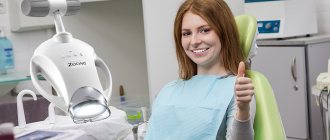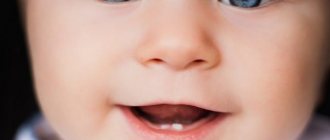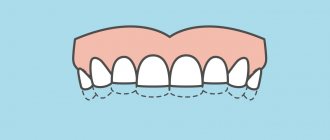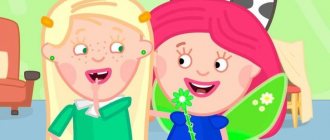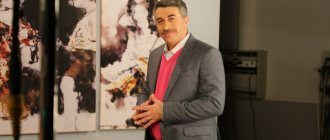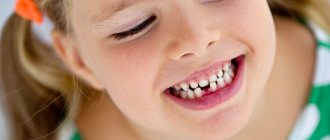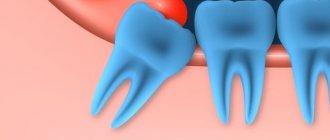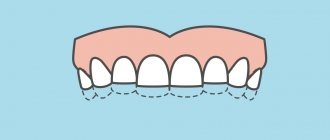Most children have their first teeth at 6-8 months. And when we see that a newborn baby has these “pearls” in his mouth, we are sincerely surprised. Indeed, the so-called natal teeth in newborns occur 1 time per 2-3 thousand crumbs. By the way, this phenomenon occurs much more often in girls than in boys.
Natal teeth are teeth that a baby develops in utero and are already present at birth. As a rule, parents observe two lower front teeth in the child’s mouth at birth. Neonatal teeth appear in a child in the first month of life.
Historians claim that Napoleon Bonaparte, Louis XIV, Julius Caesar, Charlemagne and other great people were born with natal teeth.
Are natural teeth dangerous?
In 95% of cases no. Natal and neonatal incisors are ordinary baby teeth that a child develops in the womb. The main feature of such teeth is that they usually fall out at 3-4 years.
However, natural teeth bring a lot of inconvenience to mother and child. Firstly, during feeding, the mother constantly experiences pain, because the baby unknowingly injures her nipples with his teeth. Secondly, the incisors damage the baby’s gums, frenulum and tongue. The baby develops cracks and ulcers in his mouth, the baby suffers, becomes capricious, and often cries. But, most importantly, if there are ulcers in the mouth, the child can easily get an infection on his own.
In approximately 5% of cases, natal teeth are additional. These supernumerary incisors form in the fetus on top of the baby tooth buds. This means that they will fall out very soon, leaving room for the incisors.
Types of hyperdontia
Depending on the location of the supernumerary teeth, several types of polyodontia are distinguished:
- Conical or awl-shaped tooth . In this case, excess rudiments erupt between the upper central and lateral incisors. The name of the anomaly comes from the peculiar shape of the supernumerary tooth, which looks like an awl. This form of hyperdontia is dangerous because the sharp end of the tooth often injures the mucous membrane, which is why an inflammatory process develops when an infection gets there.
- Additional molars . Such teeth grow between the main molars, displacing the dentition from the correct position.
- Extra fangs . This type of anomaly is typical for the upper jaw.
- Supernumerary premolars . These additional teeth are located on the lower jaw. Each type of anomaly looks different depending on where and how the extra teeth are located. These differences can be clearly seen in the photo.
Why do natural teeth appear?
Most dentists associate the appearance of natal teeth with the processes that occurred during pregnancy:
- unbalanced nutrition when carrying a baby;
- superficial presence of rudiments in the fetus;
- infectious diseases of a pregnant woman with high fever;
- excess calcium and vitamin D;
- diseases of the endocrine system;
- long-term exposure to toxins;
- a woman taking illicit drugs in the first trimester of pregnancy;
- congenital pathologies of the fetus;
- unfavorable environment.
Natal teeth are diagnosed immediately at the birth of the child during an examination in the maternity hospital.
It has also been recorded that children are born with natal teeth suffering from the following pathologies:
- Ellis-Van Creveld syndrome. Genetic pathology of the fetus, which is characterized by growth retardation, disproportionate dwarfism and abnormal growth of all types of bone tissue.
- Hallerman-Streiff syndrome. Many anomalies that appear due to disturbances in the visceral mesoderm of the embryo. Dysmorphia of the maxillofacial part of the skeleton.
- Sotos syndrome. A congenital, sporadic disease in which the child grows very quickly. The pathology is also characterized by accelerated development of teeth.
- Craniofacial type of synostosis. Premature closure of cranial sutures, deformation and limitation of the volume of the skull.
- Multiple steatcystoma. A benign neoplasm characterized by multiple cystic nodules on the skin.
- Cleft in the sky. The palatal parts do not fuse, a congenital disease.
- Congenital pachyonychia. A genetic disease that affects the nail plates.
- Robin's syndrome. A disease characterized by underdevelopment of the mandibular bone, palatal clefts and recessed tongue.
Features of the phenomenon
You could see what the anomaly looks like in newborns when a baby is born with teeth in the photo above. We suggest you immediately understand the terms so that the further content of the article is more understandable.
- Natal teeth are those that are present in the baby’s mouth at the time of birth.
- Neonatal teeth erupt earlier than expected. This happens in the first month of a newborn baby's life.
In this case, the tooth can be quite mature or just a thin shell without a formed root. Approximately 1 baby out of 2000-3500 newborns is born with this feature. Do not sound the alarm before all the necessary research has been carried out - in some cases, this phenomenon in newborn children is caused by fairly harmless reasons.
Classification
Natal and neonatal teeth were classified by Veronica Habling. The basis for the maturity of incisors is the quality of dental tissue, as well as the degree of its development.
Today there are four categories of natal elements:
- 1st category. The crown is shaped like a shell. The teeth have no roots, the incisors are barely fixed by the gums.
- 2nd category. Characterized by dense crowns and a very weak root structure. Often the roots of the teeth are completely absent, the tooth is weakly fixed in the alveolus.
- Category 3. The incisal edge of the tooth breaks through the gum slightly. The main part of the tooth is located inside the jaw bone.
- Category 4. The teeth can be easily felt, but are hidden by swollen tissues and are invisible to the eye.
Main reasons
Most of the reasons are not at all dangerous for the baby, although there are exceptions. They are usually associated with events that occur during the mother's pregnancy. The most common causes of this unusual phenomenon include the following.
- Poor, insufficient, unbalanced nutrition of the mother during pregnancy.
- The primary sources of teeth are located superficially.
- Severe infectious diseases of the expectant mother during gestation, which were accompanied by high fever.
- Exposure to certain types of toxins.
- Various congenital symptoms and diseases.
The doctor must find out the reason that caused the abnormal teething before the baby is born or during the first month of his life in order to decide on additional examination. This stage of diagnosis is very important in order to provide timely and high-quality help to the newborn child.
Diagnostics
As we have already said, diagnosis of natal teeth is carried out at the birth of the child. The doctor conducts a full clinical examination of the baby’s condition, evaluates the characteristics of the teeth and determines the cause of their appearance.
During the initial visual examination, the pediatrician assesses:
- mobility of incisors and their hardness;
- dental anatomy - matching the shape, color and size of the teeth;
- presence of root (if possible). If a tooth is mobile, most likely its root system is not developed or underdeveloped. It will most likely fall out on its own within a few weeks.
The doctor also conducts a mandatory examination of soft tissues:
- Examines the surface of the tongue and gum tissue. The pediatrician identifies the presence of granulomatous lesions and inflammation caused by irritation from the cutting edge of the tooth. If there is a risk of infection, the doctor advises not to save the incisors.
- Performs a general examination of the patient to exclude infections and other diseases. If necessary, the doctor prescribes a series of tests for the patient, recommends undergoing diagnostic examinations and obtaining consultations with specialists.
Diagnostic methods
Diagnosis of polyodontia is carried out exclusively by a specialized doctor - an orthodontist, who conducts a preliminary examination of the oral cavity and dentition, refers the patient to x-rays (orthopantomography) and analysis of anthropometric casts of teeth made of plaster. Such models are made for a more detailed study of a specific anomalous phenomenon, on the basis of which a diagnosis is then made and treatment is prescribed.
Table of normal human teeth. Deviation from the norm - polyodontia
When examining plaster models made on the basis of dental casts, the doctor measures the size of the teeth, and then analyzes the data obtained based on a special table by Wetzel and Ustimenko. The length of each row of teeth must be measured. This indicator may fluctuate depending on such characteristic individual characteristics of a person as crowding of teeth or the presence of large gaps between them. In the first case, the length will be less than normal, and in the second, a little longer. To diagnose asymmetry, the distance from the midline of the palate (or hyoid frenulum) to the far point of the dentition in one direction or the other is determined.
Indications for removal of natal teeth
Unusual early incisors should be removed if the doctor notices:
- The edges of the teeth are too sharp;
- Significant mobility of teeth (absence and underdevelopment of roots);
- Weakened incisor structure;
- Thin, discolored tooth enamel;
- Irregular shape of “pearls”.
If natal teeth have at least one of the problems listed above, they can injure the soft tissues of the oral cavity and mucous membranes. Moreover, teeth with weak roots can fall out at any time and fall into the respiratory tract, which is dangerous for the baby’s life.
Folk signs
There is a popular belief that if a newly born child has teeth, it means that he is endowed by nature with good health. It is also believed that early incisors are a sign of happiness and a comfortable life. Such children will grow up brave and can always respond to offenders. It is known for certain that Napoleon Bonaparte was one of these children, and in those days this was considered a great success.
According to other signs, the life of “toothy” babies is not so rosy. They will be haunted by failures in life and will have poor health. Following superstition, in order to protect the child from trouble, these teeth are removed and a special ritual is performed.
Parents do not need to worry if the baby is born with teeth. This phenomenon has been well studied in medicine, and in itself is not dangerous. In fact, a child’s health is influenced not by the presence or absence of teeth at birth, but by how he eats, in what atmosphere and care he grows up.
The video provides additional information on the topic of the article.
Preservation of teeth
Most often, natal teeth do not have any negative consequences for the child. The baby was just born special. If the parents and the doctor decide to preserve the incisors, it is worthwhile to be attentive to his oral cavity from the very first day of the child’s life.
Early teeth, much more than baby teeth, require careful care and attention. The child should be regularly shown to the dentist to have the oral cavity cleaned of bacteria.
An ideal care product and method for massaging fragile children's gums and, accordingly, natal teeth are Asepta Baby wet wipes, intended for children from 0 to 3 years old. Finger wipes prevent the growth of bacteria in the oral cavity, reduce discomfort during the eruption of subsequent baby teeth and perfectly clean all surfaces of the oral cavity.
So, now you know how to take care of a baby who was born with teeth. Don’t forget that there is a popular saying: if a child is born with incisors, a happy, rich life awaits him. The baby will grow up brave and strong, and will always be able to stand up for himself!
Experts' opinions
In most known cases, no special complications or negative consequences for the health of a child born with teeth are expected in the future. When abnormal units have not been removed, careful and daily care and regular monitoring by the dentist are important.
If there was a removal, observation by a doctor is also important. He must monitor the progress of the formation of the jaw arch, monitor the condition and quality of the milk units.
If all the rules and recommendations are followed, a baby born with teeth will be no different from his peers.
You may also be interested in
CHILDHOOD
Finger wipes from 0 to 3 years ASEPTA BABY
For gentle oral hygiene of babies and massage of gums during the eruption of the first teeth
More about the product
CHILDHOOD
Children's gel toothpaste from 0 to 3 years ASEPTA BABY
Designed for gentle care of baby's gums and baby teeth
More about the product
Reviews
Every child is unique in their own way. But sometimes phenomena occur that seem impossible to explain. But the birth of a baby with teeth no longer scares anyone and has an explanation.
If you have encountered such children or are familiar with a similar phenomenon, and would like to express your opinion about the reasons and advisability of removing “early” teeth, leave them in the comments to this article.
If you find an error, please select a piece of text and press Ctrl+Enter.
Tags children natal teeth teething
Did you like the article? stay tuned
No comments yet
How to help your baby?
Initially, the dentist will take an X-ray of the baby's jaw to make sure that the baby has the rudiments of teeth inside. If there is, then eruption will happen soon. At first, the gums will swell a little and salivation will become very abundant: these are the main symptoms of the rapid appearance of teeth. You can help them a little:
- Teether toys are an excellent device for training gums; they help relieve severe itching and reduce pain.
- Mothers should learn how to gently massage their baby’s gums. It is better to massage with a clean finger lubricated with a special gel for children's gums.
- It is important to add healthy purees and healthy foods to your baby’s diet that will help the child’s body receive the necessary microelements and vitamins.
If the baby generally develops within normal limits, eats well, sleeps, is active and cheerful, then the absence of teeth at 1 year is definitely not a reason to panic. Each child develops at his own pace. In general, boys tend to lag slightly behind girls in some physiological parameters.
From this article it follows that you should not worry unnecessarily! If in any doubt, seek advice from a pediatric dentist at our Babydent
Show more tips
Bite
Abnormal bite often causes:
- increased load on individual teeth, which contributes to their rapid destruction or damage to the ligamentous apparatus;
- crowding of teeth, leading to gum inflammation and dental caries.
- The hereditary factor is detected in no more than 50% of cases of abnormal structure of the dental system. The remaining 50% is due to the following circumstances:
- artificial feeding;
- formation of bad habits at an early age (sucking pacifiers, fingers, lips, holding pencils or pens in the mouth);
- the habit of sleeping in one position, especially with your hand under your cheek;
- incorrect posture;
- lack of calcium and other trace elements in the body.
In preventing the development of pathological occlusion, the role of parents is great, who should pay attention to the early identification and elimination of provoking factors.
